Royal Australian Navy
The Royal Australian Navy (RAN) is the naval branch of the Australian Defence Force. Following the Federation of Australia in 1901, the ships and resources of the separate colonial navies were integrated into a national force, called the Commonwealth Naval Forces. Originally intended for local defence, the navy was granted the title of 'Royal Australian Navy' in 1911, and became increasingly responsible for defence of the region.
| Royal Australian Navy | |
|---|---|
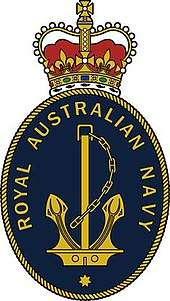 | |
| Founded | 1911 |
| Country | Australia |
| Type | Navy |
| Size | 13,650 Permanent personnel[1] 2,925 Reserve personnel[1] 46 commissioned ships 3 non-commissioned ships |
| Part of | Australian Defence Force |
| Headquarters | Russell Offices, Canberra |
| Motto(s) | Serving Australia with Pride |
| March | "Royal Australian Navy" |
| Anniversaries | 10 July |
| Engagements |
|
| Website | www |
| Commanders | |
| Commander-in-chief | Elizabeth II, represented by General David Hurley (As Governor-General of Australia) |
| Chief of the Defence Force | General Angus Campbell |
| Vice Chief of the Defence Force | Vice Admiral David Johnston |
| Chief of Navy | Vice Admiral Michael Noonan |
| Deputy Chief of Navy | Rear Admiral Mark Hammond |
| Commander Australian Fleet | Rear Admiral Jonathan Mead |
| Insignia | |
| Naval ensign (1967–present) | 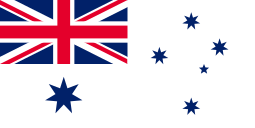 |
| Naval ensign (1911–1967) |  |
| Naval jack | .svg.png) |
| Queen's Colour | 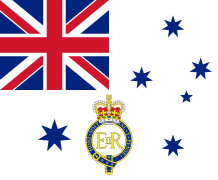 |
| Aircraft flown | |
| Reconnaissance | Sikorsky MH-60R Seahawk |
| Trainer | Airbus Helicopters EC135 T2+ |
| Transport | MRH-90 Taipan |
Britain's Royal Navy’s Australian Squadron was assigned to the Australia Station and provided support to the RAN. The Australian and New Zealand governments helped to fund the Australian Squadron until 1913, while the Admiralty committed itself to keeping the Squadron at a constant strength.[2] The Australian Squadron ceased on 4 October 1913, when RAN ships entered Sydney Harbour for the first time.[2]
The Royal Navy continued to provide blue-water defence capability in the Pacific up to the early years of the Second World War. Then, rapid wartime expansion saw the acquisition of large surface vessels and the building of many smaller warships. In the decade following the war, the RAN acquired a small number of aircraft carriers, the last of which was decommissioned in 1982.
Today, the RAN consists of 46 commissioned vessels, 3 non-commissioned vessels and over 16,000 personnel. The navy is one of the largest and most sophisticated naval forces in the South Pacific region, with a significant presence in the Indian Ocean and worldwide operations in support of military campaigns and peacekeeping missions. The current Chief of Navy is Vice Admiral Michael Noonan.
History
The Commonwealth Naval Forces were established on 1 March 1901, two months after the federation of Australia, when the naval forces of the separate Australian colonies were amalgamated. A period of uncertainty followed as the policy makers sought to determine the newly established force's requirements and purpose, with the debate focusing upon whether Australia's naval force would be structured mainly for local defence or whether it would be designed to serve as a fleet unit within a larger imperial force, controlled centrally by the British Admiralty.[3] In 1908–09, the decision was made to pursue a compromise solution, and the Australian government agreed to establish a force that would be used for local defence but which would be capable of forming a fleet unit within the imperial naval strategy, albeit without central control. As a result, the navy's force structure was set at "one battlecruiser, three light cruisers, six destroyers and three submarines".[4]
On 10 July 1911, King George V granted the service the title of "Royal Australian Navy".[5] The first of the RAN's new vessels, the destroyer Yarra, was completed in September 1910 and by the outbreak of the First World War the majority of the RAN's planned new fleet had been realised.[4] The Australian Squadron was placed under control of the British Admiralty,[6] and initially it was tasked with capturing many of Germany's South Pacific colonies and protecting Australian shipping from the German East Asia Squadron. Later in the war, most of the RAN's major ships operated as part of Royal Navy forces in the Mediterranean and North Seas, and then later in the Adriatic, and then the Black Sea following the surrender of the Ottoman Empire.[4]
In 1919, the RAN received a force of six destroyers, three sloops and six submarines from the Royal Navy,[7] but throughout the 1920s and early 1930s, the RAN was drastically reduced in size due to a variety of factors including political apathy and economic hardship as a result of the Great Depression.[8] In this time the focus of Australia's naval policy shifted from defence against invasion to trade protection,[9] and several fleet units were sunk as targets or scrapped. By 1923, the size of the navy had fallen to eight vessels,[8] and by the end of the decade it had fallen further to five, with just 3,500 personnel.[9] In the late 1930s, as international tensions increased, the RAN was modernised and expanded, with the service receiving primacy of funding over the Army and Air Force during this time as Australia began to prepare for war.[9]
Early in the Second World War, RAN ships again operated as part of Royal Navy formations, many serving with distinction in the Mediterranean, the Red Sea, the Persian Gulf, the Indian Ocean, and off the West African coast.[10] Following the outbreak of the Pacific War and the virtual destruction of Allied naval forces in south-east Asia, the RAN operated more independently, or as part of United States Navy formations. As the navy took on an even greater role, it was expanded significantly and at its height the RAN was the fourth-largest navy in the world, with 39,650 personnel operating 337 warships.[9] A total of 34 vessels were lost during the war, including three cruisers and four destroyers.[11]
After the Second World War, the size of the RAN was again reduced, but it gained new capabilities with the acquisition of two aircraft carriers, Sydney and Melbourne.[12] The RAN saw action in many Cold War–era conflicts in the Asia-Pacific region and operated alongside the Royal Navy and United States Navy off Korea, Malaysia, and Vietnam.[13] Since the end of the Cold War, the RAN has been part of Coalition forces in the Persian Gulf and Indian Ocean, operating in support of Operation Slipper and undertaking counter piracy operations. It was also deployed in support of Australian peacekeeping operations in East Timor and the Solomon Islands.[14]
The high demand for personnel in the Second World War led to the establishment of the Women's Royal Australian Naval Service (WRANS) branch in 1942, where over 3,000 women served in shore-based positions. The WRANS was disbanded in 1947, but then re-established in 1951 during the Cold War. It was given permanent status in 1959, and the RAN was the final branch to integrate women in the Australian military in 1985.[15]
RAN today
Command structure
The strategic command structure of the RAN was overhauled during the New Generation Navy changes.[16] The RAN is commanded through Naval Headquarters (NHQ) in Canberra.[17] The professional head is the Chief of Navy (CN), who holds the rank of vice admiral.[18] NHQ is responsible for implementing policy decisions handed down from the Department of Defence and for overseeing tactical and operational issues that are the purview of the subordinate commands.[19]
Beneath NHQ are two subordinate commands:
- Fleet Command: fleet command is led by Commander Australian Fleet (COMAUSFLT). COMAUSFLT holds the rank of rear admiral; previously, this post was Flag Officer Commanding HM's Australian Fleet (FOCAF), created in 1911,[20] but the title was changed in 1988 to the Maritime Commander Australia. On 1 February 2007, the title changed again, becoming Commander Australian Fleet.[21] The nominated at-sea commander is Commodore Warfare (COMWAR), a one-star deployable task group commander. Fleet command has responsibility to CN for the full command of assigned assets, and to Joint Operations command for the provision of operationally ready forces.
- Navy Strategic Command: the administrative element overseeing the RAN's training, engineering and logistical support needs. Instituted in 2000, the Systems Commander was appointed at the rank of commodore; in June 2008, the position was upgraded to the rank of rear admiral.
Fleet Command was previously made up of seven Force Element Groups, but after the New Generation Navy changes, this was restructured into four Force Commands:[22]
- Fleet Air Arm, responsible for the navy's aviation assets
- Mine Warfare, Clearance Diving, Hydrographic, Meteorological and Patrol Forces, an amalgamation of the previous Patrol Boat, Hydrographic, and Mine Warfare and Clearance Diving Forces, operating what are collectively termed the RAN's "minor war vessels"
- Submarine Force, (Royal Australian Navy Submarine Service) operating the Collins-class submarines
- Surface Force, covering the RAN's surface combatants (generally ships of frigate size or larger)
Fleet
As of October 2018, the RAN fleet consisted of 48 warships, including destroyers, frigates, submarines, patrol boats and auxiliary ships.[23] Ships commissioned into the RAN are given the prefix HMAS (His/Her Majesty's Australian Ship).[24]
The RAN has two primary bases for its fleet:[25][26]
- Fleet Base East, located at HMAS Kuttabul, Sydney; and
- Fleet Base West, located at HMAS Stirling, near Perth.
In addition, three other bases are home to the majority of the RAN's minor war vessels:[27][28][29]
- HMAS Cairns, at Cairns;
- HMAS Coonawarra, at Darwin; and
- HMAS Waterhen, at Sydney.
Current ships
The RAN currently operates 46 commissioned vessels, made up of eight ship classes and three individual ships, plus three non-commissioned vessels. In addition, DMS Maritime operates a large number of civilian-crewed vessels under contract to the Australian Defence Force.
| Commissioned vessels | |||||
|---|---|---|---|---|---|
| Image | Class/name | Type | Number | Entered service | Details |
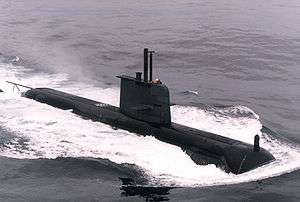 HMAS Collins, Collins class | Collins class | Submarine | 6 | 2000 | Anti-shipping, intelligence collection. Diesel-electric powered. |
 HMAS Canberra, Canberra class | Canberra class | Landing helicopter dock | 2 | 2014 | Amphibious warfare ships with aircraft carrier capacity. |
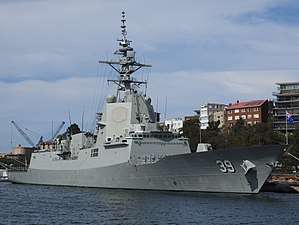 | Hobart class | Destroyer | 3 | 2017 | Air Warfare Destroyer.[30] |
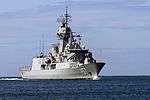 HMAS Perth, Anzac class | Anzac class | Frigate | 8 | 1996 | Anti-submarine and anti-aircraft frigate with 1 helicopter. Two more were built for the Royal New Zealand Navy. |
.jpg) HMAS Broome, Armidale class | Armidale class | Patrol boat | 13 | 2005 | Coastal defence, maritime border, and fishery protection. One has been decommissioned |
HMAS Yarra, Huon class | Huon class | Minehunter | 4 (2) | 1997 | Minehunting. Four active, two laid up. |
HMAS Leeuwin, Leeuwin class | Leeuwin class | Survey ship | 2 | 2000 | Hydrographic survey |
_at_IFR.jpg) HMAS Benalla, Paluma class | Paluma class | Survey launch | 4 | 1989 | Hydrographic survey |
| HMAS Choules (Bay class) | Landing Ship Dock | 1 | 2011 | Heavy sealift and transport | |
 HMAS Sirius | HMAS Sirius | Replenishment ship | 1 | 2006 | Replenishment at sea and afloat support. Modified commercial tanker. |
| Non-commissioned vessels | |||||
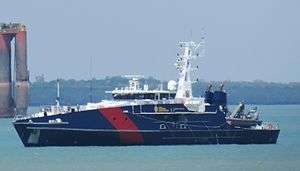 ABFC Cape St George, Cape class | Cape class | Patrol boat | 2(6) | 2015 | Cape Byron and Cape Nelson were leased from the Australian Border Force to supplement Armidales during classwide remediation maintenance. ADV (Australian Defence Vessel) ship prefix. 6 more ordered in May 2020 for delivery between 2021 and 2023[31] |
.jpg) STS Young Endeavour | STS Young Endeavour | Tall Ship | 1 | 1988 | Sail training ship |
Aviation
Fleet Air Arm
The Fleet Air Arm (previously known as the Australian Navy Aviation Group) provides the RAN's aviation capability. As of 2018, the FAA consists of two front line helicopter squadrons (one focused on anti-submarine and anti-shipping warfare and the other a transport unit), two training squadrons and a trials squadron.[32]
LADS Flight
In addition to the helicopter squadrons of the Fleet Air Arm, the RAN operated an additional flying unit that came under the operational responsibility of the Australian Hydrographic Service. The Laser Airborne Depth Sounder (LADS) Flight was the sole remaining fixed-wing aircraft operated by the RAN, and was based at HMAS Cairns in Cairns, Queensland.[33] The final LADS flight was conducted in November 2019. The capability will be replaced by commercial hydrographic companies through the HydroScheme Industry Partnership Program (HIPP).[34]
Gallery
- MRH-90 of 808 Squadron
 A RAN MH-60R Seahawk
A RAN MH-60R Seahawk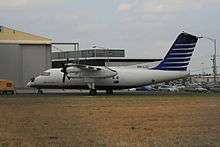 Bombardier Dash 8 of the LADS Flight
Bombardier Dash 8 of the LADS Flight
Clearance Diving Branch
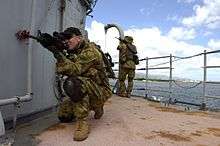
The Clearance Diving Branch is composed of two Clearance Diving Teams (CDT) that serve as parent units for naval clearance divers:
- Clearance Diving Team 1 (AUSCDT ONE), based at HMAS Waterhen in New South Wales; and
- Clearance Diving Team 4 (AUSCDT FOUR), based at HMAS Stirling in Western Australia.
When clearance divers are sent into combat, Clearance Diving Team Three (AUSCDT THREE) is formed.
The CDTs have two primary roles:
- Mine counter-measures (MCM) and explosive ordnance disposal (EOD); and
- Maritime tactical operations.
Future
There are currently several major projects underway that will see upgrades to RAN capabilities:
- Project SEA 1180 Phase 1 is building twelve Arafura-class offshore patrol vessels based on the Lürssen OPV80 design, to replace Armidale-class patrol boats. Construction started in November 2018, with the first vessel, HMAS Arafura to enter service in Q4 2021.[35]
- Project SEA 1429 Phase 2 is upgrading the Collins-class submarines with the Mk48 Mod 7 CBASS torpedo.[36] Initial Operational Capability (IOC) was achieved in May 2008[36] with Final Operational Capability (FOC) due in December 2018, 60 months late.[36]
- Project SEA 1439 Phase 3 is upgrading the Collins-class submarine platform systems to improve 'reliability, sustainability, safety and capability'. IOC was achieved in October 2007, FOC is due in September 2022.[37]
- Project SEA 1439 Phase 4A is replacing the Collins-class submarines' combat system with the AN/BYG-1(V)8 developed in conjunction with the US Navy[38] IOC Expected to achieve Final Operating Capability in December 2018.[39] IOC was in May 2008 with FOC planned for December 2018.
- Project SEA 1654 Phase 3 is acquiring two Supply-class replenishment ships based on the Spanish Cantabria-class oiler. HMAS Supply was launched in November 2018[40] and will replace HMAS Success, while the second, HMAS Stalwart will replace HMAS Sirius.
- Project SEA 5000 Phase 1 is acquiring nine Hunter-class frigates based on the British Type 26 Global Combat Ship, to replace the Anzac-class frigates in the late 2020s. The vessels will be built in Adelaide by BAE Systems, with the first three to be named HMA Ships Hunter, Flinders and Tasman.[41]
- Project SEA 1000 is the procurement of twelve submarines of the Attack-class, a diesel-electric version of the French Barracuda-class nuclear submarine which should enter service in the 2030s, with the first boat to be named HMAS Attack.
- On the 1 May 2020, the Minister for Defence announced that 6 evolved Cape-class patrol boats had been ordered as a form of economic stimulus following the economic impact of the 2019-2020 Coronavirus Pandemic. The 6 ships are worth around $350 Million and will be built by Austal in Henderson, Western Australia.[31]
- Project SEA 1905 is the acquisition of a further 2 Arafura-class offshore patrol vessels in a mine counter-measures configuration.[42]
- Project SEA 2400 s the Hyrdographic Data Collection Capability Program which includes the introduction of a Strategic Military Survey Capability(SMSB) to replace the Leeuwin-class survey vessels.[42]
Current operations
The RAN currently has forces deployed on four major operations:[43]
- Operation Highroad: Australia's commitment to the International Coalition forces in the Afghanistan War;
- Operation Resolute: border protection;
- Operation Manitou: counter-piracy, counter-terrorism and maritime stability in the Middle East; and
- Operation Accordion: support operation to provide sustainment to forces deployed on Operations Highroad and Manitou.
Personnel
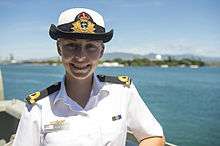
As of June 2011, the RAN has 14,215 permanent full-time personnel, 161 gap year personnel, and 2,150 reserve personnel.[44] The permanent full-time force consisted of 3,357 commissioned officers, and 10,697 enlisted personnel.[44] In June 2010, male personnel made up 82% of the permanent full-time force, while female personnel made up 18%.[45] The RAN has the highest percentage of women in the ADF, compared to the RAAF's 17.8% and the Army's 9.7%.[45]
The following are the current senior Royal Australian Navy officers:
- Vice Admiral David Johnston – Vice Chief of the Defence Force
- Vice Admiral Michael Noonan – Chief of Navy
- Rear Admiral Mark Hammond – Deputy Chief of Navy
- Rear Admiral Jonathan Mead – Commander Australian Fleet
- Rear Admiral Peter Quinn – Head Navy Capability
- Rear Admiral Colin Lawrence – Head Navy Engineering
- Rear Admiral Bruce Kafer – Director-General Australian Navy Cadets and Reserves
- Commodore Brett Brace – Hydrographer of Australia
- Warrant Officer Deb Butterworth – Warrant Officer of the Navy
Ranks and uniforms
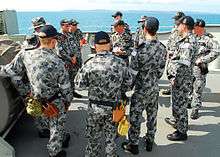
The uniforms of the Royal Australian Navy are very similar in cut, colour and insignia to their British Royal Navy forerunners. However, beginning with the Second World War, all RAN personnel began wearing shoulder flashes reading Australia, a practice continuing today. These are cloth arcs at shoulder height on uniforms, metallic gold on officers' shoulder boards, and embroidered on shoulder slip-ons.
Commissioned officers
Commissioned officers of the Australian Navy have pay grades ranging from S-1 to O-11. The only O-11 position in the navy is honorary and has only ever been held by royalty, currently being held by The Duke of Edinburgh. The highest position occupied in the current Royal Australian Navy structure is O-9, a vice admiral who serves as the Chief of the Navy. O-8 (rear admiral) to O-11 (admiral of the fleet) are referred to as flag officers, O-5 (commander) and above are referred to as senior officers, while S-1 (midshipman) to O-4 (lieutenant commander) are referred to as junior officers. All officers of the navy receive a commission from Her Majesty Queen Elizabeth II, Queen of Australia. The commissioning scroll issued in recognition of the commission is signed by the Governor General of Australia as Commander-in-Chief and the serving Minister for Defence.
Naval officers are trained at the Royal Australian Naval College (HMAS Creswell) in Jervis Bay and the Australian Defence Force Academy in Canberra.[47]
| Commissioned officer rank structure of the Royal Australian Navy | |||||
|---|---|---|---|---|---|
| Admiral of the Fleet | Admiral | Vice Admiral | Rear Admiral | Commodore | Captain |
| O-11 | O-10 | O-9 | O-8 | O-7 | O-6 |
 _OF-10.svg.png) |
 _OF-9.svg.png) |
 _OF-8.svg.png) |
 _OF-7.svg.png) |
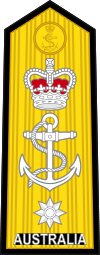 _OF-6.svg.png) |
_OF-5.svg.png) |
| AF | ADML | VADM | RADM | CDRE | CAPT |
| Commander | Lieutenant Commander | Lieutenant | Sub Lieutenant | Acting Sub Lieutenant | Midshipman |
|---|---|---|---|---|---|
| O-5 | O-4 | O-3 | O-2 | O-1 | S-1 |
_OF-4.svg.png) |
_OF-3.svg.png) |
_OF-2.svg.png) |
_OF-1.svg.png) |
_OF-1.svg.png) |
 |
| CMDR | LCDR | LEUT | SBLT | ASLT | MIDN |
Chaplain
Chaplains in the Royal Australian Navy are commissioned officers who complete the same training as other officers in the RAN at the Royal Australian Naval College, HMAS Creswell. RAN regulations group RAN chaplains with commanders for purposes of protocol such as marks of respect (saluting); however, RAN chaplains have no other rank other than "chaplain", and their rank emblem is identifiable by a Maltese cross with gold anchor. Senior chaplains are grouped with captains, and principal chaplains are grouped with commodores, but their chaplain rank slide remains the same. Principal chaplains, however, have gold braid on the peak of their white service cap.
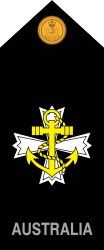
Other ranks
| Other ranks | ||||||||
|---|---|---|---|---|---|---|---|---|
| Warrant Officer of the Navy | Warrant Officer | Chief Petty Officer | Petty Officer | Leading Seaman | Able Seaman | Seaman | ||
| E-10 | E-9 | E-8 | E-7 | E-6 | E-5 | E-4 | E-3 | E-2 |
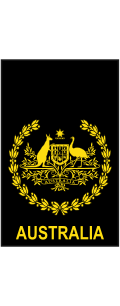 |
 |
 |
(No rank) |  |
 |
(No rank) |  |
 |
| WO-N | WO | CPO | PO | LS | AB | SMN | ||

Royal Australian Navy Other Ranks wear "right arm rates" insignia, called "Category Insignia" to indicate speciality training qualifications.[48] The use pattern mirrors that of the Royal Navy, and has since formation. Stars or a Crown are added to these to indicate higher qualifications.
Special insignia
The Warrant Officer of the Navy (WO-N) is an appointment held by the most senior sailor in the RAN, and holds the rank of warrant officer (WO). However, the WO-N does not wear the WO rank insignia; instead, they wear the special insignia of the appointment.[49] The WO-N appointment has similar equivalent appointments in the other services, each holding the rank of warrant officer, each being the most senior sailor/soldier/airman in that service, and each wearing their own special insignia rather than their rank insignia. The Australian Army equivalent is the Regimental Sergeant Major of the Army (RSM-A)[50] and the Royal Australian Air Force equivalent is the Warrant Officer of the Air Force (WOFF-AF).[51]
See also
- Australian Navy Cadets
- Australian White Ensign
- Battle and theatre honours of the Royal Australian Navy
- Royal Australian Navy School of Underwater Medicine
References
Notes
- Defence Annual Reports 2017-2018. Department of Defence. 2018. p. 29.
- Dennis, Peter; Grey, Jeffrey; Morris, Ewan; Prior, Robin (2008). The Oxford Companion to Australian Military History (2nd ed.). South Melbourne, VIC: Oxford University Press. ISBN 978-0-19-551784-2. OCLC 271822831.
- Dennis et al 1995, p. 516.
- Whitley 2000, p. 17.
- Stevens, David. "The R.A.N. – A Brief History". Royal Australian Navy. Retrieved 10 August 2013.
- Dennis et al 1995, p. 517.
- Gillett & Graham 1977, p. 193.
- Gillett & Graham 1977, p. 61.
- Dennis et al 1995 p. 518.
- Gillett & Graham 1977, pp. 69–76.
- Gillett & Graham 1977, p. 93.
- Gillett & Graham 1977, p. 94.
- Dennis et al 1995, pp. 519–520.
- "Database of Royal Australian Navy Operations, 1990–2005" (PDF). Working Paper No. 18. Sea Power Centre. Archived from the original (PDF) on 27 February 2012. Retrieved 24 August 2014.
- Dennis et al 1995, pp. 607–608.
- Sea Power Centre, Australia (April 2009). "The Spirit of the Navy" (PDF). Semaphore. Australian Government Department of Defence (5). Retrieved 3 January 2019.
- "Navy Strategic Command". Royal Australian Navy. Australian Government Department of Defence. 6 June 2018. Retrieved 3 January 2019.
Navy Strategic Command [...] is headquartered in Canberra
- "Senior Leadership Team". Royal Australian Navy. Australian Government Department of Defence. 26 July 2018. Retrieved 3 January 2019.
The Chief of Navy Australia is the most senior appointment in the Royal Australian Navy. The rank associated with the position is Vice Admiral (3-star).
- "Defence Organisational Structure Chart" (PDF). Australian Government Department of Defence. Commonwealth of Australia. 17 December 2018. Retrieved 3 January 2019.
- C L Cumberlege Archived 3 March 2016 at the Wayback Machine
- "Top Stories". Archived from the original on 10 March 2007.
- Australian Maritime Doctrine. p. 124.
- "Current Ships". Royal Australian Navy. Retrieved 23 September 2017.
- Frame 2004, p. 96.
- "Fleet Base East". Royal Australian Navy. Retrieved 31 August 2014.
- "Fleet Base West". Royal Australian Navy. Retrieved 31 August 2014.
- "HMAS Cairns". Royal Australian Navy. Retrieved 31 August 2014.
- "HMAS Coonawarra". Royal Australian Navy. Retrieved 31 August 2014.
- "HMAS Waterhen". Royal Australian Navy. Retrieved 31 August 2014.
- Navy, Royal Australian. "Warship Sydney commissions at sea". Navy Daily. Retrieved 19 May 2020.
- Nicholson, Dylan; Nicholson, Dylan (30 April 2020). "Navy to get new patrol boats to boost capability". www.defenceconnect.com.au. Retrieved 3 May 2020.
- "Fleet Air Arm". Royal Australian Navy. Retrieved 30 October 2018.
- "Laser Airborne Depth Sounder". Royal Australian Navy. Retrieved 24 April 2014.
- "Final LADS flight - a job well done". Royal Australian Navy.
- "Offshore Patrol Vessels". Department of Defence (Australia). Retrieved 29 June 2018.
- "ANAO Report No. 26 2017–18". Australian National Audit Office. pp. 331–338. Retrieved 12 February 2019.
- "Collins Class Submarine reliability and sustainability". Department of Defence (Australia). December 2017. Retrieved 12 February 2019.
- "Collins Class Submarine Replacement Combat System". Department of Defence Science & Technology. 2019. Retrieved 12 February 2019.
- "Collins Replacement Combat System". Department of Defence (Australia). February 2018. Retrieved 29 June 2018.
- "RAN's next oiler ship launched in Spain". Australian Defence Magazine. 26 November 2018.
- Wroe, David (28 June 2018). "British frigate program to seed Australia's own warship industry, Turnbull says". The Sydney Morning Herald. Retrieved 28 June 2018.
- "Draft Infrastructure & Land Use Plan" (PDF). Western Australian Government. 18 June 2020.
- "Operations". Royal Australian Navy. Retrieved 31 August 2014.
- Department of Defence (2011). Portfolio Budget Statements 2011–12: Defence Portfolio (PDF). Canberra: Commonwealth of Australia. p. 39. ISBN 978-0-642-29739-6. Archived from the original (PDF) on 8 September 2011.
- "Defence Annual Report 2009-2010, Appendix 7, Table A7.3".
- "Navy Training: Officer Training". Defence Jobs. Retrieved 31 August 2014.
- "Category Badges". Royal Australian Navy. Retrieved 1 August 2015.
- "Defence Leaders: Navy". www.defence.gov.au. Retrieved 10 August 2013.
- "Regimental Sergeant Major – Army". www.army.gov.au. Archived from the original on 9 June 2012.
- "Warrant Officer of the Air Force". www.airforce.gov.au.
Bibliography
- Bogart, Charles H. (2006). "The Royal Australian Navy: A Pictorial Look at the 1980s". Warship International. XLIII (2): 195–221. ISSN 0043-0374.
- Dennis, Peter; Grey, Jeffrey; Morris, Ewan; Prior, Robin (1995). The Oxford Companion to Australian Military History. Melbourne: Oxford University Press. ISBN 0-19-553227-9.
- Frame, Tom (2004). No Pleasure Cruise: The Story of the Royal Australian Navy. Crows Nest, New South Wales: Allen & Unwin. ISBN 1-74114-233-4.
- Gillett, Ross; Graham, Colin (1977). Warships of Australia. Adelaide, South Australia: Rigby. ISBN 0-7270-0472-7.
- Whitley, M. J. (2000) [1988]. Destroyers of World War Two: An International Encyclopedia. London: Cassell. ISBN 1-85409-521-8.
External links
| Wikimedia Commons has media related to Royal Australian Navy. |
- Royal Australian Navy home page
- Maritimequest Royal Australian Navy photo gallery
- Biographies of senior RAN officers
- Royal and Dominion Navies in World War II, Campaigns, Battles, Warship losses
- ADF Pay & Conditions Manual – Equivalent ranks and classifications